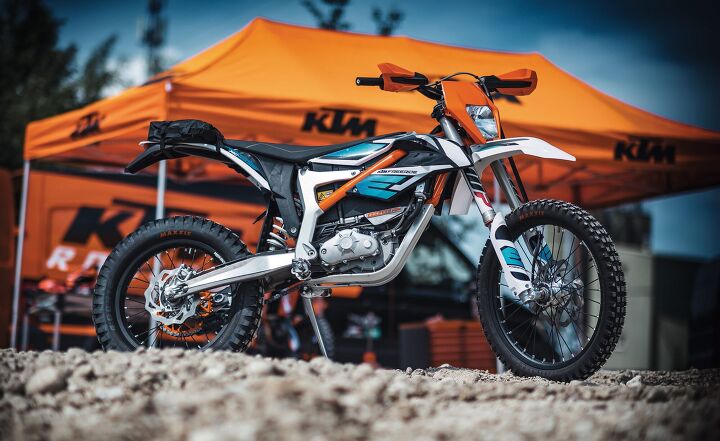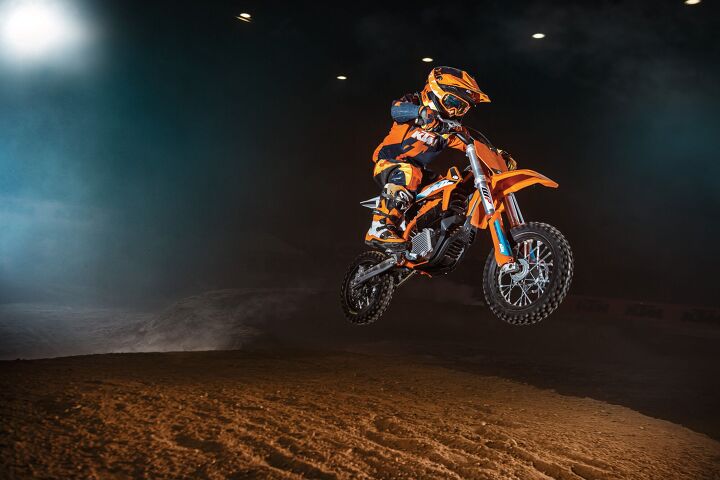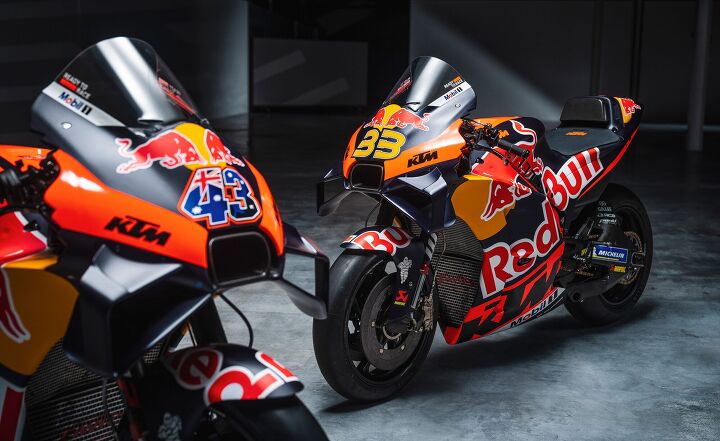Motorsports Racing News & Blog Articles
Interview with KTM’s Stefan Pierer – Part 3
Alan Cathcart’s conversation with Stefan Pierer continues, as the PIERER Mobility president and chief executive officer discusses electrification and other future technologies. —ED.
Interview with KTM’s Stefan Pierer – Part 1
Interview with KTM’s Stefan Pierer – Part 2
Alan Cathcart: Looking at PIERER Mobility’s electric model development, GASGAS already has its own electric Trials bike, but to what extent will other brands within the PIERER family go electric as well? So will KTM ever have a mainstream electric model, like a scooter?
Stefan Pierer: Well, we have already an electric model, the Freeride, plus all the kids’ bikes. You know KTM’s chosen field for product development. If you stop in front of a restaurant or beer garden, riding an E-bike, you take off your helmet and everybody is looking to you, and you’re proud to be riding a silent electric motorcycle – but if it’s a scooter, it’s different. Very different! So that’s the reason we don’t have any KTM E-scooters. That’s Piaggio’s job, not mine – they make them very nicely, big respect.
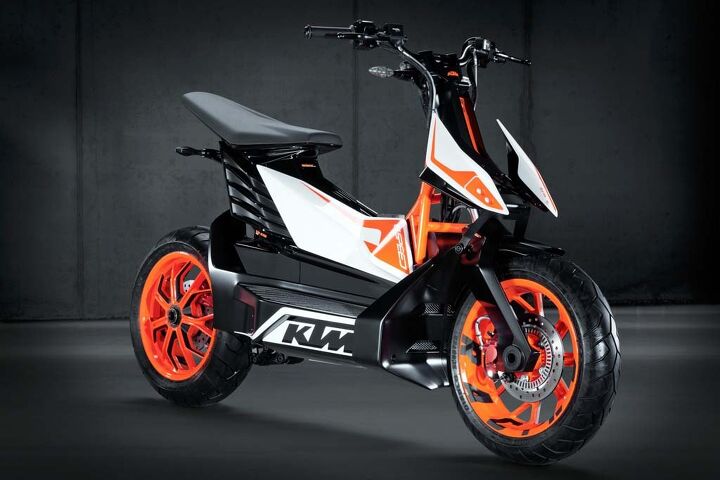
KTM revealed its E-Speed concept ten years ago but electric scooters are no longer part of PIERER Mobility’s plans.
AC: But CFMOTO has an E-scooter.
SP: Yes, they launched it at EICMA last year – we already processed it to fulfil European regulations, so if it works, we’ll take it into distribution. They call it the ZEEHO, though my advice was they should brand it as a CFMOTO product, model ZEEHO, which would help with marketing. Talking and announcing is one thing, but consistently delivering and getting market share – that’s another. Let’s see what happens!
Look, concerning electric powered two-wheelers I’m telling everybody the same thing. Because very often I get asked in investors meetings, “What about your motorcycles equipped with electric powertrains?” and then we get talking about energy density, which with a combustion engine is 0.8 kilograms per litre. If you want to get the same energy density with a lithium-ion battery pack, you’re adding up to ten times the size – ten times. I’ve been riding an Enduro bike with 9 or 10 litres of gasoline, where should I put in the 100 kilos to get the electric equivalent – maybe in my rucksack or on the luggage rack?? Don’t talk about an Adventure bike with pretensions for covering big distances on or off-road. This is stupid. Starting 15 years ago I have seen high voltage E-companies each slump into a financial crisis – Vectrix wound up 120 million Euro in debt, Zero if you look closely, it’s burning money, and so on. Harley LiveWire? Completely unprofitable! All the new electric start-ups burn money – they’re completely non-viable commercially. But as soon as it’s a small battery, that’s different. We are selling kid’s Motocross electric bikes very nicely – with a small battery, you keep your margin. Then in seven years’ time when the youngster turns 16, he’s already used to electric, so then he’s asking for a bigger version of that, which means you must get ready to supply him with what he wants. Simple!
AC: So are you ready for electric off-road, or electric MX or electric Trials?
SP: We are the pioneer in that, and in 2013 we launched our Freeride and the next-generation model will come in 2024, so it’s clear we’re moving ahead on that. In countries like Austria, in tourist areas where it’s forbidden to ride combustion engines, it’s the only choice you have, and you put the money on the table because you want to do your sport. Or, if you look at Paris, we’re not allowed anymore to ride with a combustion engine, so you’ll need an electric scooter or something like that to ride through the streets.
AC: So do you believe this will expand all the way around Europe and the rest of the world?
SP: Yes, but it’s not what I would call an aggressive business case, it’s just as soon as it’s legally forced, you have to provide something, and kid’s products are perfect, just perfect. Look, you are not anymore the mechanic for your kid. Secondly, it’s safer because you can do it in your neighbourhood, even in your garden without disturbing your neighbour. And don’t underrate the real decision maker who is the mother, and if the product is silent, she perceives it as safe, as it is.
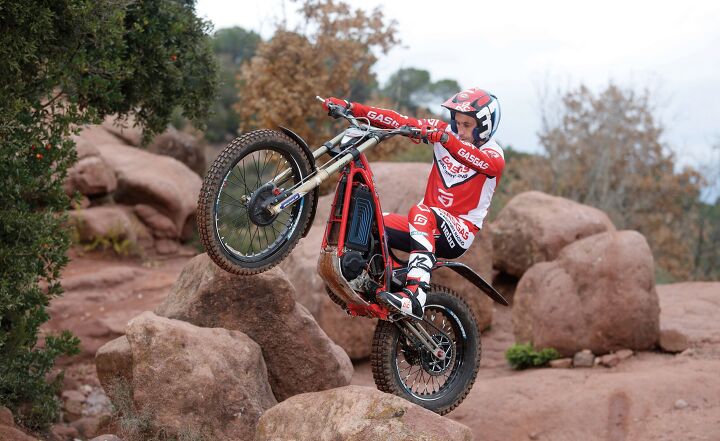
The GasGas TXE actually predates the brand’s acquisition by PIERER Mobility, but application of electricity to a trial bike still makes a lot of sense.
AC: But looking at adult electric sport, is Trials the most obvious discipline which should become electric?
SP: Yes, it’s already in the process, that’s clear, Trial is perfect, we don’t need a big battery, especially the torque is helpful to make you jump, whatever, but that’s clear. And also a segment which we stepped in three years ago, it’s clear that electric bicycles, basically the E-bike business became a huge business, a big market, though to be strictly truthful, it’s a Hybrid, because you’re pedalling as well as having your electric motor and the battery pack!
AC: Are you still manufacturing your E-bikes in Bulgaria?
SP: Yes, and every year more, because I have a strategic mission, which is to bring all bicycles presently manufactured in Asia back to Europe! It’s a stupid business case, because everything is done over there at present. As a manufacturer you have to order one and a half years in advance, you have to secure all your ordering, hopefully you have specified it in the right quantity and to the right specification, and then you must wait for one year to sell it through your channels. You end up tying up working capital for six months, which is the most idiotic business case I have ever seen. And your customer is in Europe, so you have to ship it all the way here from Asia – it’s totally stupid. We know how it all works from our motorcycle business, so we have set up a strategic alliance with Maxcom in Bulgaria, and now we are building an additional factory there, we have brought back frame manufacturing because the frame is the first component you need – you have to have something to put everything in, and for suspension, you can imagine how it works with WP. It’ll take three or four years, but trust me, we’ll bring electric bicycle manufacture back to Europe.
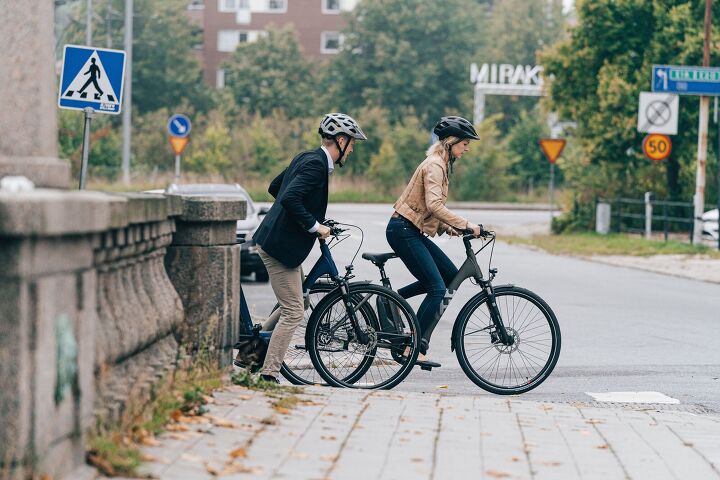
PIERER Mobility’s electric bicycle portfolio includes models under its Husqvarna and GasGas brands. Photo by Dan Gustavsson.
AC: Only in Bulgaria, or in other countries, too?
SP: In Bulgaria wages are the most attractive in Europe, because even in the Czech Republic and Hungary there is nearly full employment. So if in Austria you have 100% of workers in jobs, then in the Czech Republic and Hungary it’s 80-85%, but in Bulgaria it’s still just 60%.
AC: To the point that you might consider purchasing Maxcom?
SP: No, I’m used to working alliances – as soon as you want to own it 100%, you have to run it, and then you have to go to Bulgaria. I prefer to stay here in Austria!
AC: What is the potential annual manufacturing volume of the new factory? How many can you build each year, and will they be branded as Husqvarna, or R Raymon, or KTM?
SP: Currently we can do 350,000 bikes a year, and with the new factory it’s increasing as quickly as possible to half a million, 500,000 units. We have stopped using the R Raymon name, and replaced it with GASGAS. Husqvarna is perceived globally as a nice, safe consumer brand, with different products like chainsaws, lawn mowers, sewing machines and all that, and now electric bicycles. Interestingly, in the bicycle industry it’s not like in the motorcycle market, people are not brand driven, so an average 70% of customers that come in to the store don’t have any clue which brand they want to buy. They have just one idea – they want a mountain bike, a city bike, whatever – but then the sales guy is steering the customer to that brand where he’s getting his commission. It reminds me of 30 years ago in the motorcycle distribution network, and it will develop in a similar way, that the dealer is providing the product lines of one OEM, or maximum two. And for that you must have a program to allow him to earn money, and to do that you must become a global player. That means for us, in the long term we have to do a million sales annually, and as quick as we can, 500,000 units. And we do have an advantage compared to the bicycle OEMs, because we have our own sales network on the motorcycling side with 4,500 dealers, and the electric bicycle is a powered two-wheeler! You have a powertrain, you have a battery pack, you have a shifting system and a warranty which you must provide, so everything that a motorcycle dealer is ideally placed to serve.
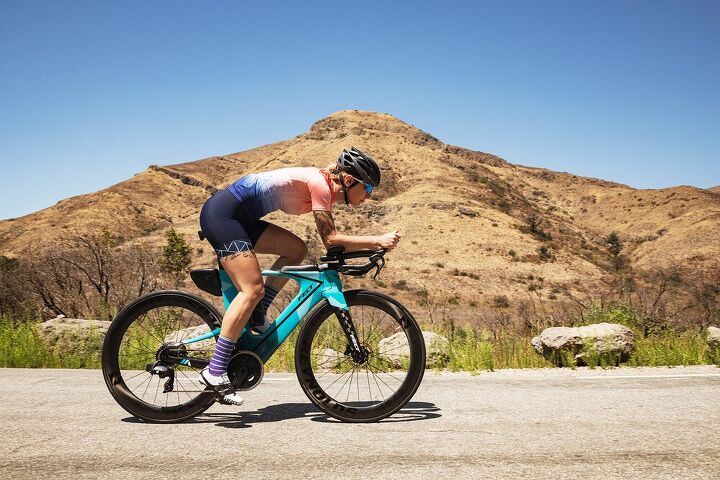
American brand Felt Racing of Irvine, California, is also part of PIERER Mobility’s portfolio. Photo by Jordan Clark Haggard.
AC: OK, but for a motorcycle dealer to sell electric, doesn’t he have to make a significant extra investment to meet safety requirements?
SP: No, not true – it’s a 48-volt product, so it’s simple. That’s what we have learnt with our E-products, we launched a high voltage 320-volt concept with the Freeride, and then there were huge restrictions on production, because it’s always risky for safety. Both logistically and at the dealer level we all had to invest quite a lot of capital. But 48 volts like in the bicycle industry you can also use on a motorcycle or a scooter up to 11kW. As soon as you step upwards beyond that, you are heading towards high voltage, and then you have restrictions on production, logistics and dealer. So 11kW is the ceiling we’ll go to.
AC: For your off-road electric models, will you make it easy to exchange batteries?
SP: No, it’s too complicated and expensive – it’s just increasing your production costs.
AC: What is PIERER Mobility’s overall policy for zero emission strategies? Are you interested in developing synthetic fuel?
SP: Yes, for sure – we heavily support that, we have set up alliances or lobbying groups for synthetic fuel with many different European companies. In Austria as well, we are one of the leading participants, and in Saudi Arabia and the Emirates, they are starting to make the necessary huge investment in equipment for producing synthetic fuel on a commercially viable industrial basis.
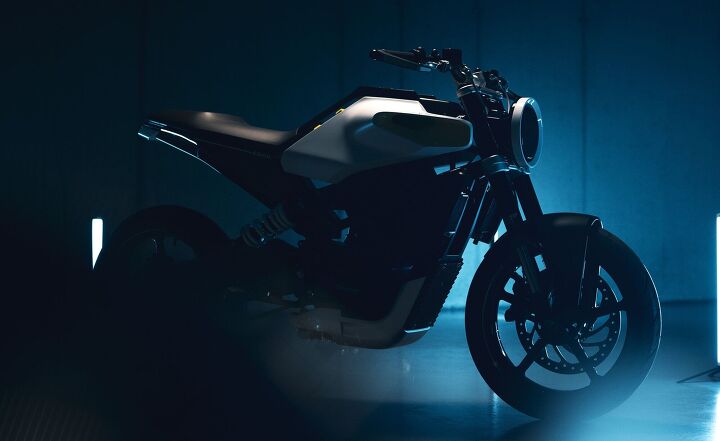
The Husqvarna E-Pilen Concept has clearly been developed with the urban commuter and leisure rider in mind. Photo by Rudi Schedl.
AC: Is it a future strategy for PIERER Mobility that electric products would be confined to urban mobility?
SP: Yes, but maybe up to the equivalent of 125cc, so you can also use it in the countryside. For sure, mopeds typically can be replaced by electric, but what is the tank of a moped, six or seven litres, and this delivers a mileage which is quite OK. But the battery pack presently needed for such a mileage with the electric equivalent is too big, because as a young guy, what are you doing on a weekend? Go for a ride, but if you get lost never again will you step on an electric! These are just simple things the customer is deciding, not the politicians.
AC: Well, maybe there are politicians who are trying to insist to the customer that they know best, but synthetic fuel gives the customer the chance to say no.
SP: Yes, that’s right – and now they are finally recognizing that we have 1.6 billion combustion vehicles around the globe, so how should we deal with these? Fortunately, just recently when Brussels was trying to introduce a ban from 2035 onwards for all new combustion engines, the German and Italian ministers achieved an exemption for synthetic fuel-equipped vehicles.
AC: BMW Motorrad is extremely focused on synthetic fuel – are you too?
SP: Yes, the whole industry, because we are all participants, the Japanese, the Indians, all of us.
AC: Yes, but particularly you and BMW – are you working together on this?
SP: Yes, because for an average customer of a sportbike or leisure bike in developed markets like Europe, what is their average mileage a year – 3,000km, maximum. So, with that, the price of the fuel doesn’t make any impact. So despite synthetic fuel being more expensive, at least to start with, if you want to pursue your hobby without being stranded in the middle of nowhere because you ran out of charge, this is the perfect solution. Such customers will never buy electric.
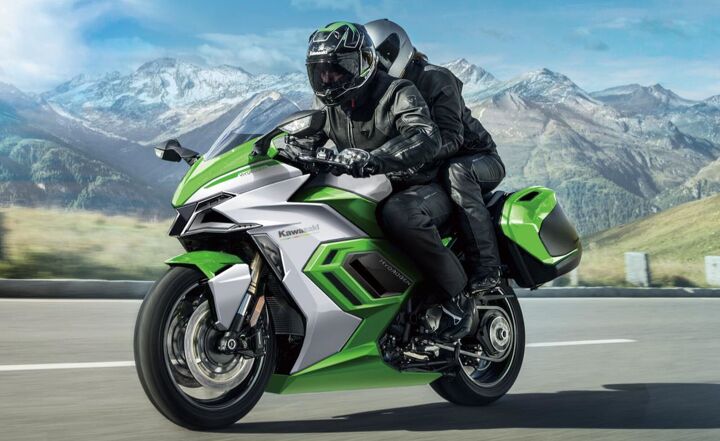
Kawasaki is developing hydrogen-combustion models but Stefan Pierer sees synthetic fuel as a more viable path.
AC: How about hydrogen? The four Japanese companies are pursuing a joint venture on this, so are you looking at that, too?
SP: No. Since the politicians have finally recognized electric is not the real solution, now everybody is talking about hydrogen, but they don’t have any clue how this would work. It’s expensive, and also the logistics are not easy. Even if you have liquid hydrogen, you can’t use existing pipelines to bring it to the existing point of sale. Hydrogen is the smallest and lightest molecule in the Universe, so it leaks easily and to prevent its release requires costly solutions. For sure, for industry, for steel makers and suchlike in my opinion hydrogen is the only way forward, and it could also be an ideal solution for large trucks, buses and so on – but the infrastructure is complicated, and expensive. Although there exists already a delivery system, which just happens to sell gasoline and diesel at the moment, you’re not able to use this immediately to distribute hydrogen, you have to adapt it. And that’s the advantage of synthetic fuel, you can distribute it right away, so for covering any significant distance synthetic fuel will be key. It’s a scientific gasoline, and you can fill your existing motorcycle with it, and it works just fine. Look, in MotoGP we are going in 2024 to a blend of 40% synthetic with conventional race fuel, and in 2026 or 2027 it should go to 100%, like in Formula 1. Together, we will save the planet – and have fun racing!
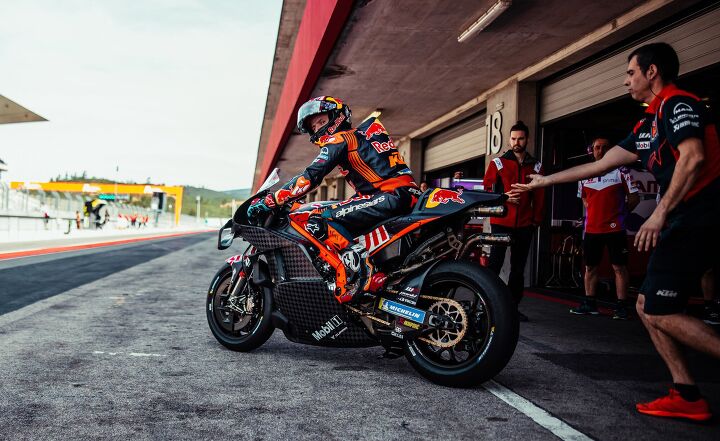
The 2023 MotoGP season kicks off this weekend with Jack Miller joining Brad Binder on the Red Bull KTM team.Photo by Rob Gray (Polarity Photo).
AC: So that brings us to MotoGP, where you have a new KTM rider this year in Jack Miller, and a GASGAS team as well as a KTM team. Is it true that your biggest problem at the moment in being competitive is qualifying? Come race day, Brad Binder is certainly a Sunday guy, and Jack, too, so is this the problem?
SP: Basically, it’s similar to Formula 1 in that you must have a qualifying bike and a qualifying set up, then a race bike. For 2023 we think we’re competitive, but let’s see. Last year we underestimated the importance of aerodynamics, which became a key element in being competitive, but it’s just increasing the costs. Fortunately we have a close relationship to Red Bull, so they helped us, and we managed to stop the introduction of that stupid idea of the movable ride height in races. I sometimes get the impression that the Italian manufacturers want to use MotoGP only as a means of developing these crazy ideas that they have lying in bed at night into something that could maybe work on a motorcycle. Gigi Dall’Igna is a great guy, he’s always finding new ideas, and what’s not covered by the rules, oh, that’s racing – so it’s OK. I’m not complaining about his capacity for innovation, only about the constantly increasing costs they bring with them. Because, mark my words, sooner or later probably from 2027 onwards, for sure we will have to introduce cost controls. Look, Suzuki made a decision to retire from MotoGP on cost grounds with a race-winning bike, so don’t underrate the importance of this.
AC: Do you feel the reason they withdrew was that they simply weren’t prepared to spend the extra money needed for aerodynamics?
SP: Yes – but it’s not only aerodynamics, it’s everything. Let me tell you, you need at least a 70 million Euro budget for two bikes for a single season, otherwise you’re not competitive. And for Suzuki, not going racing was a strategic marketing decision based on value for the money they spent, which is quite understandable.
AC: Given the focus on alternative fuels, what’s your long-term projection for KTM’s two-stroke models?
SP: When I started in KTM 30 years ago back in 1992, I had to take the decision whether or not to produce a new 125cc two-stroke engine platform. But at that time we didn’t really have the liquidity to support it, so we were thinking very seriously, should we do it or not? So many comments were made that the two-stroke is dead, but finally I said – that’s the only new engine platform that we can afford to do, because a two-stroke motor is much cheaper to develop than a four-stroke, so let’s do it. And 30 years later it’s still alive in a quantity which I shouldn’t name, but if you twist my arm we’re talking about 50,000 bikes a year! Honda tried to stop everyone making such bikes, but now Yamaha has come back with them, too. We convinced them! I remember in 2000 the Japanese told me in Tokyo, “We stopped with the two-stroke, everything is heading towards four-stroke.” OK, but because of that racing got much more expensive, with really high end technology, because a four-stroke top end is almost rocket science – 15,000 rpm, titanium valves, all those kinds of things. But we will continue to make the two-stroke at KTM because the customer wants it, and with direct fuel injection we can even achieve street-legal homologation.
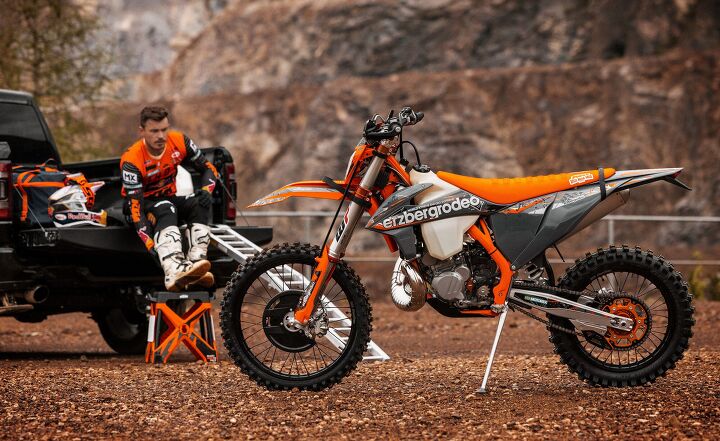
KTM hasn’t stopped producing two-stroke models, and Stefan Pierer says that will continue. Photo by Markus Berger.
AC: If you can now obtain Euro 5 compliance with a fuel-injected two stroke, will you make a road bike powered by such a motor?
SP: No road bike – sorry, I know it would be popular, but we won’t do it. I’m fighting enough wars with the bureaucrats already! Off-road only with on-road compliance where necessary for Enduro models is where we draw the line.
Become a Motorcycle.com insider. Get the latest motorcycle news first by subscribing to our newsletter here.
The post Interview with KTM’s Stefan Pierer – Part 3 appeared first on Motorcycle.com.
Copyright
© Motorcycle.com


